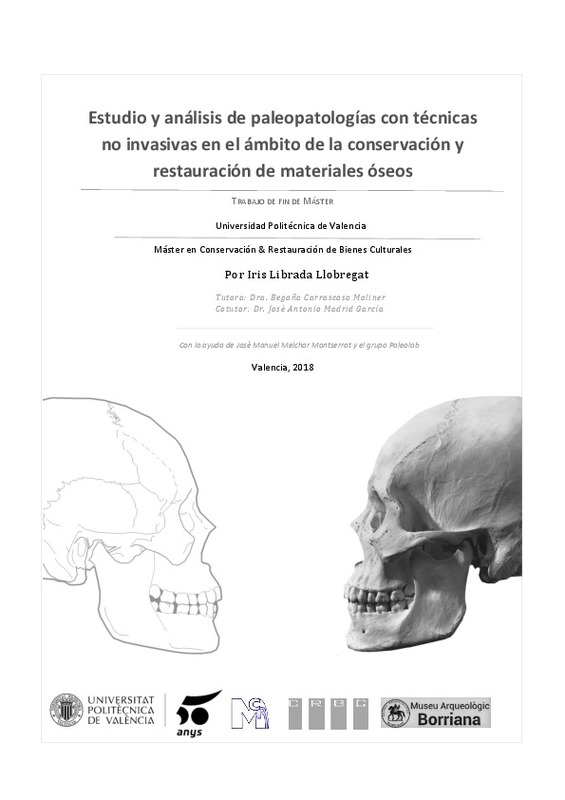|
Resumen:
|
[ES] El siguiente trabajo trata sobre el análisis, estudio y manipulación de piezas óseas con paleopatologías en humanos para su investigación mediante técnicas no invasivas de Rayos X. Con los resultados obtenidos y el ...[+]
[ES] El siguiente trabajo trata sobre el análisis, estudio y manipulación de piezas óseas con paleopatologías en humanos para su investigación mediante técnicas no invasivas de Rayos X. Con los resultados obtenidos y el contexto de las piezas se puede conseguir información etnográfica, social, cultural e histórica del estilo de vida y tipo de alimentación.
Todo este proceso se realizará bajo el punto de vista de la restauración y conservación de materiales arqueológicos, elaborando informes de las piezas con los datos obtenidos, su catalogación e inventariado y el desarrollo de una propuesta de intervención en caso de necesidad con su correspondiente presupuesto y medidas conservativas para su correcto almacenamiento y exposición, dependiendo de la ubicación y destino de la pieza. Además se llevará acabo la recopilación de la documentación del yacimiento arqueológico, lugar de procedencia, método de extracción de las piezas y cualquier dato que pueda ser relevante para el estudio.
También se procederá a realizar el estudio organoléptico para asignar el estado de conservación. A partir de toda la información obtenida se elaborará la ficha técnica donde aparecerán el lugar de procedencia, las medidas, la datación, la descripción, el siglado, el número de piezas, información de los sujetos así como edad, altura o asignación de género, las paleopatologías identificadas y el registro fotográfico.
El estudio de técnicas de Rayos X se realizará mediante un equipo de técnica radiográfica digital desarrollada, optimizando la calidad de las radiografías y apto para diversos formatos. Este método está adaptado para obras de arte en el ámbito de la restauración y conservación de bienes culturales, aportando grandes ventajas en el estudio e interpretación de las piezas, debido a la calidad que ofrece.
El papel de los restauradores y su correcto criterio en la manipulación de piezas arqueológicas y las necesidades de cada material es esencial para garantizar la estabilidad de la pieza y su perdurabilidad en el tiempo.
[-]
[EN] The following work is about the analysis, study and manipulation of bone pieces thorough the use of paleopathologies in humans for its investigation using non-invasive X-ray techniques. Based on the results obtained ...[+]
[EN] The following work is about the analysis, study and manipulation of bone pieces thorough the use of paleopathologies in humans for its investigation using non-invasive X-ray techniques. Based on the results obtained and the context of the pieces we can obtain ethnographic, social, cultural and historical information regarding to lifestyle and feeding.
All this process will be carried out in accordance with the restoration and conservation of archaeological materials principles by writing reports of the pieces with the obtained information, their cataloging and inventory. In addition, in case of need, we would insert the intervention proposal with the corresponding budget and conservative measures for correct storage and exposure according to the piece location and destination. Moreover, a document compilation related to the archaeological site, origin place, pieces extraction method and any data that may be relevant for the study will also be carried out.
It will also be included an organoleptic study in order to determine the conservation state. With all the obtained information, a technical specific sheet will be made to classify data related to the place of origin, the measurements, the dating, the description, the stamping, the pieces number, the fellows information as well as the age, the gender s height, the identified paleopathologies and the photographic record.
The study of X-ray techniques will be made through a technique using a digital radiographic equipment that will optimize the radiographs quality, being suitable for different formats. This method is adapted to art works within the field of restoration and conservation of the cultural heritage, providing great advantages in the study and interpretation of pieces due to the quality it offers.
The restorer s role and the correct judgment in the handling of archaeological pieces and the needs of each material is essential to guarantee the stability of the piece and its durability over time.
[-]
|







